Bottoming Consumer Prices and Commodities– Confirmations and Conclusions
Commodities / CRB Index May 29, 2009 - 02:32 PM GMTBy: Andy_Sutton
 In a mid-February editorial we took a look at some factors that were beginning to confirm one of our proprietary indicators that pointed to a bottoming in consumer prices in December 2008. Writing such an article at the time was a big risk since it flew in the face of a trend that had been firmly in place for the past half-year. The price of nearly everything was falling – or so it seemed. For those who understand and appreciate the function of money supply in the determination of prices, the article made perfect sense.
In a mid-February editorial we took a look at some factors that were beginning to confirm one of our proprietary indicators that pointed to a bottoming in consumer prices in December 2008. Writing such an article at the time was a big risk since it flew in the face of a trend that had been firmly in place for the past half-year. The price of nearly everything was falling – or so it seemed. For those who understand and appreciate the function of money supply in the determination of prices, the article made perfect sense.
However, for those who believe that economic growth or the absence thereof determines prices, there was a great deal of consternation regarding our assertions. Nearly three months have passed since then and almost every piece of data that has come across this desk has validated the claims made back in February.
Just aside of the factors we mentioned in the February article, which were the CRB Index, Gold, and West Texas Intermediate Crude, there is another major indicator of this phenomenon and that is the stock market. From the 3/6/2009 bottom through today, the Dow Jones Wilshire 5000 Index raced from 6935 to 9342; an increase of 34.71%. More importantly though, lets look at it in terms of dollars. The value of the Wilshire 5000, which is one of the broadest measures of US market capitalization increased by $2.407 Trillion during that relatively short period of time.
It is utterly preposterous to assume that Mr. and Mrs. America dug in the couch and found that kind of money and decided to invest it. It is even more preposterous considering the environment that the real economy is dealing with at this time. Job losses have been staggering and persistent, it is demonstrably difficult for the unemployed to find work, and house prices are still falling like an elephant dropped from the Empire State Building. How else do we know this increase didn’t come from the real economy? Let’s look at past behavior. When the government handed out $168 billion in stimulus checks – essentially ‘free money’ - did the public invest it in the stock market? No. The public paid bills, or saved it – much to the consternation of the government.
So where did this dramatic bear market rally come from? In my opinion, it came from large institutional investors – many of the same people who had their coffers stuffed with TARP money over the past 6 months and the same folks who were essentially given a free pass a while back when the rules for mark to market accounting were relaxed. So what we have here is largely an inflationary rally. Certainly, this is not the first such rally, and it will most assuredly not be the last.
But it isn’t just the stock market. It is the commodities markets as well, and this is where it gets bad for consumers. We are about to witness a wave of inflation, a magnitude of which has never before been seen in America. Dr. Marc Faber had this to say about the subject:
“I am 100 percent sure that the U.S. will go into hyperinflation,” Faber said. “The problem with government debt growing so much is that when the time will come and the Fed should increase interest rates, they will be very reluctant to do so and so inflation will start to accelerate. He also added, “The global economy won’t return to the “prosperity” of 2006 and 2007 even as it rebounds from a recession”.
Let’s revisit our charts and positions from February and see how much things have changed in just three months:
Reuters/Jefferies CRB Index
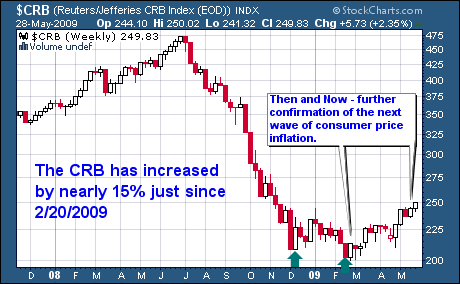
The 15% increase in just the past 3 months will not immediately be seen on store shelves, but it is already being seen at the gas pump and in the prices of many consumer items. It must be noted that the US economy contracted at a rate of 5.7% (annualized) in the first quarter of 2009, which is on the heels of a 6.1% decrease in the fourth quarter of 2008, yet consumer prices, commodities, and other inflation assets are rising. If this doesn’t strike down the notion that demand (economic growth) alone determines prices, then nothing will.
West Texas Intermediate Crude Oil (WTIC)
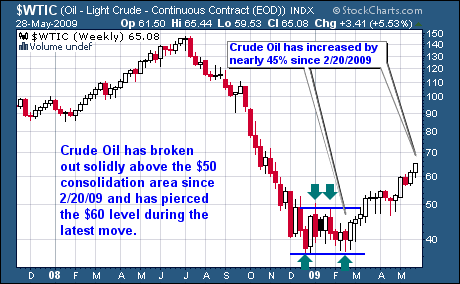
This one says it all – a 45% increase in the price of oil just since the middle of February. Keep in mind this increase in price has occurred during a period of a contracting US economy. It is high time that the mainstream press and every one of us stop being US centric when it comes to oil – and everything else for that matter. World demand has remained robust, but at the same time has not exploded over the past six months for sure. The problem is there are untold trillions of dollars parked around the globe. Remember last fall that it wasn’t just the US Fed who was printing like crazy. The Europeans were following suit, much to the dismay of any country that possesses a scarce resource.
Gold – Contract Price
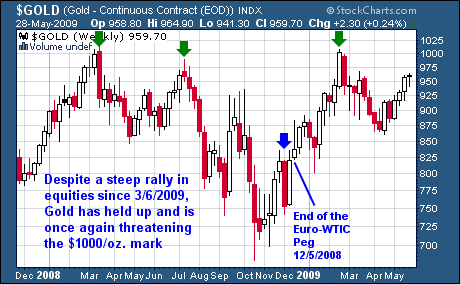
Despite a major rally in equities and assertions from media and government alike that the economy has bottomed and will begin to heal soon, Gold has not taken the bait. After once again breaking through the $1000/oz level for a brief period in late February, Gold was pushed down to the $860 area, but has rallied nearly $100/oz in relentless fashion and is looking for its fourth straight week of gains. It is very obvious that the powers that be would prefer if Gold remained below the psychologically critical $1000/oz mark. A serious breakout to the upside would once again light the 1970’s-esque fire of inflationary expectations.
The US Dollar – Heads they win, tails we lose
The story for the US Dollar over the past year has been a fairly simple one: if there is a major crisis and stock markets are falling 700 points in a day, then people want dollars. Otherwise, forget it. So the only way holders of dollars get a break is if the wheels are falling off everything else. During periods of relative calm, such as what we are seeing now, the Dollar has retaken its outcast position as the whipping boy among currencies. The damage done by numerous bailouts and stimulus packages is common sense. The future damage of persistent trillion dollar annual deficits and tens of trillions in unfunded liabilities from Social Security and Medicare still remains.
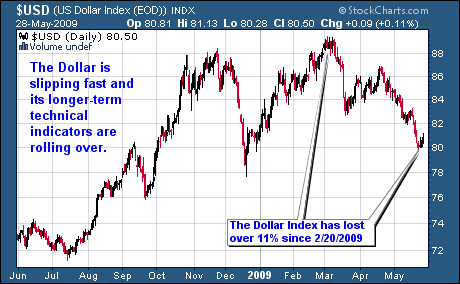
The 11% move in the Dollar from 2/20/09 to the present will result in higher prices paid for imports, and in part has been one of the reasons for oil’s recent surge. However, oil’s move has been far in excess of what would have been necessary to merely keep pace with the dollar’s decay. Look for a return to higher trade deficits unless demand drops concomitantly, which is entirely possible.
The return of the Bond Vigilantes
Perhaps worst of all has been the Fed’s inability to keep bond yields under control. Despite open monetization to the tune of $300 Billion, and the 2009 purchases of upwards of $1.25 Trillion in mortgage bonds in an effort to keep rates low, bond rates have shot up dramatically. Perhaps even worse, mortgage bond yields are now starting to move up as well. The most alarming trend is the 10-2 spread for 10-year and 2-year Treasury notes. It cannot be ignored that with each recession, the spread grows. That is because each time the fears of inflation as well as actual inflation itself increase dramatically. It cannot be ignored that with each spike we have seen a large bolus of inflation enter the system resulting in a period of ‘prosperity’. Anyone care to stretch their thinking a bit and notice how those periods of ‘prosperity’ are getting shorter and shorter despite greater infusions of fiat cash?
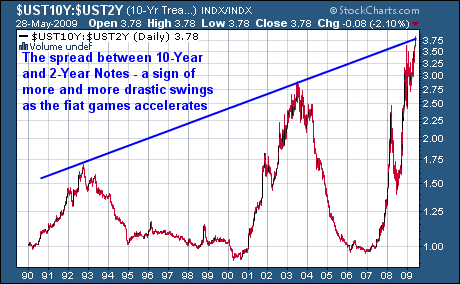
It should now be apparent to all that a massive inflationary wave has been unleashed. Policymakers are aware of this and are already preparing the public by discussing deficits in the trillions rather than billions as the government will make a futile attempt to keep pace. What is most alarming in all of this is the precarious position of the consumer. Nearly wiped out in 2008 by job losses, falling home prices (which had previously been regarded as income), stagnant wages, and dramatic losses in retirement and other investments, the consumer is not in the position to deal with the inflationary blow that is now in progress.
The green shoots theory was a nice try, but those shoots are about to be buried under an avalanche of another type of green – the green of increasingly worthless fiat paper money.
In our ‘Spin Cycle’ podcast, we are currently doing a 7-part series in which we depict the factors affecting the US economy as sides of a Rubik’s Cube – independent, yet interrelated. On June 3rd, we welcome Professor Laurence Kotlikoff to discuss generational accounting and our mounting debt. To listen, visit www.my2centsonline.com/radioshow.php
By Andy Sutton
http://www.my2centsonline.com
Andy Sutton holds a MBA with Honors in Economics from Moravian College and is a member of Omicron Delta Epsilon International Honor Society in Economics. His firm, Sutton & Associates, LLC currently provides financial planning services to a growing book of clients using a conservative approach aimed at accumulating high quality, income producing assets while providing protection against a falling dollar. For more information visit www.suttonfinance.net
Andy Sutton Archive |
© 2005-2022 http://www.MarketOracle.co.uk - The Market Oracle is a FREE Daily Financial Markets Analysis & Forecasting online publication.



